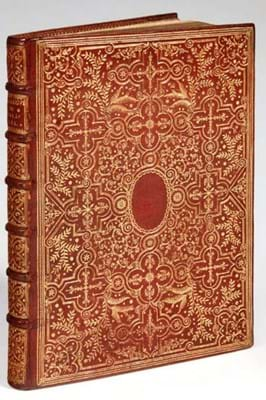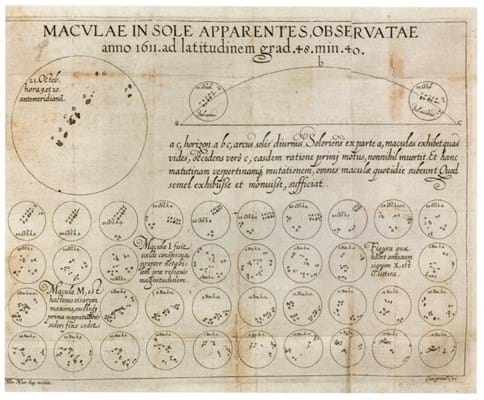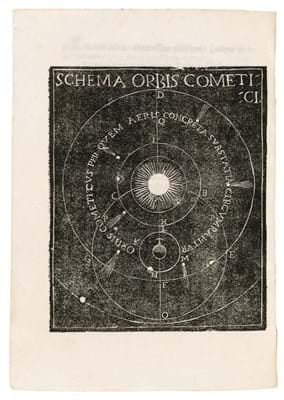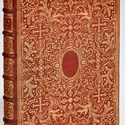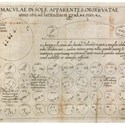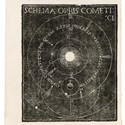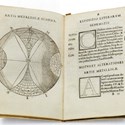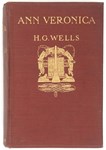This was a work which offered both a defence of the Copernican, heliocentric view of the solar system and a risky portrayal of his old friend and protector Maffeo Baberini, Pope Urban III. The pope is depicted as one of the three figures who discuss the merits of Copernican proposal – the simple-minded ‘Simplicius’, an adherent to the old Ptolemaic and Aristotelian theories.
Galileo was found guilty, but though his original sentence of life imprisonment was commuted to house arrest, the printing of any of his works was forbidden and the Dialogo… itself remained on the Catholic church’s ‘Index Librorum Prohibitorum’ for another 200 years.
A distraught Galileo was eventually persuaded by a more sympathetic churchman, Ascenio Piccolomini, Archbishop of Siena, to produce a work that pulled together his life’s work in physics.
Discorsi e dimostrazioni matematiche… refers in the extended title to …due nove scienze, the engineering science of the strength of materials and the mathematical science of kinematics, but the work also deals with uniform and accelerated motion and parabolic trajectories.
Like the condemned Dialogo…, this too was presented as a discussion between three figures representing the old, the new and the impartial views and beliefs.
Already forbidden to publish in Florence or Rome and unable to obtain a licence to print in Venice, Galileo arranged to have the manuscript smuggled out of Italy. It went first to France, and then to the Elzevirs in Holland, from whose Leiden press it was issued in 1638.
On April 26, when some 300 books and manuscripts from the library of Jean A Bonna were offered in Paris by Pierre Bergé & Sotheby’s (24/20.5/17% buyer’s premium), a stunning copy of that Leiden edition in a beautiful ‘à la fanfare’ binding of red morocco gilt by Le Gascon sold for a record €727,219 (£615,955), including premiums and taxes.
This was a first state copy of the work that was specially bound for presentation to the dedicatee, François de Noailles, Comte d’Ayen, who, as French ambassador in Rome, had been the man who arranged for Galileo’s manuscript to be delivered to the Elzevirs.
The previous auction best for the work was €65,000, paid for a copy in contemporary vellum offered by Christie’s Paris in 2004.
Third slice of Beltrame
Astronomical works featured strongly in the April 26 sale at Christie’s (25/20/12% buyer’s premium) of a third selection of items from the scientific library of Giancarlo Beltrame.
Like the previous sales of July and November last year, it covered a great many fields of scientific study and discovery in its 416 lots.
The real Beltrame treasures in the astronomy field had been offered in the first sale.
Then, the ex-Honeyman-Garden copy of Rheticus’ brief 1540 account of Copernicus’ as yet unpublished heliocentric theories sold at £1.55m, and a number of other astronomical rarities made six-figure sums in a sale that raised over £5m in all.
In this third Beltrame sale the sums paid were more modest but these were still rare and important works and a few had made no previous mark on auction records.
Meditazione poetica sopra I pianeti Medicei, printed in Venice in 1610, is a nine-page poem inspired by Galileo’s telescopic discovery of the satellites of Jupiter. The work of Girolamo Magagnati, a student of chemistry and manufacturer of coloured glass with a love of verse-making, it is a great rarity and the Beltrame copy, in a modern binding, made a much higher than expected and presumably record £15,000.
Giulio Cesare La Galla’s De phenomenis in orbis lunae… relates to what became known as the Galilean controversy. The author was a professor of philosophy in Rome when, in 1611, Galileo arrived to present his new telescope and explain the discoveries made with it.
“In this third Beltrame sale the sums paid were more modest but these were still rare and important works
La Galla was given a number of opportunities to try the new instrument and its technical capabilities are not questioned in his tract. But as an Aristotelian he refused to accept the irregularity of the moon’s surface, and he therefore questioned how the observations in Galileo’s Sidereus nuncius of 1610, the foundation work of modern astronomy, had been interpreted.
The Beltrame copy of the 1612, Venetian first of La Galla’s work was in a modern binding, had a number of faults of condition and lacked the folding engraved table, but its rarity meant bidding reached £12,000.
Sun spot spotter
Christoph Scheiner, a professor of Hebrew and mathematics at Ingolstadt, constructed his own telescope and first detected the phenomenon of spots on the sun in March 1611.
Scheiner believed the spots to be small planets circling the sun but as a Jesuit was unable to publish this evidence in support of Copernicanism under his own name and instead communicated the discovery to his friend Marcus Welser of Augsburg.
The latter had Scheiner’s work printed and sent copies abroad to Galileo and Kepler, among others. However, Galileo, in his Istoria e dimostrazioni intorno alle macchie solari e loro accidenti of 1613, argued that the spots were actually on the rotating sun and not tiny satellites of it.
Under the pseudonym of Apelles, Scheiner’s original letters to Welser were even printed at the conclusion of Galileo’s great work and despite the differences in interpretation – enlivened by a dispute over priority – telescopic evidence had persuaded both astronomers of the correctness of the Copernican system.
A very rare copy in old vellum of the 1612, Augsburg printing of Scheiner’s letters to Welser, the Tres epistolae…, sold at £6000, while bid to £8000 was a copy in modern but old style calf of his Rosa Ursina…, printed on the private press established at his castle by Paolo Orsini, Duke of Bracciano and a patron of astronomical studies.
The latter is Scheiner’s major work, expanding upon his researches into sunspots and including among the numerous engraved illustrations his important lunar map, the first equatorially mounted telescope, called a helioscope, and other instruments.
Making telescopes
Sold for £8000 was a presentation copy in period vellum of the 1618, Frankfurt first of Girolamo Sirtori’s Telescopium…, the first monograph to describe the manufacture of telescopes. It includes instructions and diagrams for building a refracting telescope and also provides the first detailed account of Galileo’s telescope.
A copy that Sirtori gave to Tommaso Mignoni, physician to both the Holy Roman Emperor and Elector Palatine, it had been sold for £570 when offered as part of the great Honeyman scientific library at Sotheby’s in 1981.
Two copies of this scarce work were present in the Macclesfield Library and sold for £22,000 and £26,000 at Sotheby’s in 2004, but in both instances were bound up with other works.
Sold for a record £7500 was a 1622 first in period vellum of Giovanni Battista Stelluti’s Scandaglio…, a defence of Galileo against the publications of Orazio Grassi. Differences in their opinions on the 1618 comet had spawned numerous pamphlets on both sides of the argument and in this work Galileo’s friends tried to refute Grassi’s claims.
It had been published under the name of the brother of the better-known Francesco Stelluti, a friend of Galileo and Prince Cesi, who was helping Galileo prepare Il Saggiatore. That definitive response to Grassi contains large sections of material copied directly from Scandaglio…
Scandaglio… was published in Terni, a small town near Cesi’s estate at Acquasparta in Umbria.
“Wright aimed to reach an understanding of the Milky Way
Milky musings
One of the last lots to be offered in the Beltrame sale was a copy in contemporary calf of the 1750, first and only edition of Thomas Wright’s An original theory or new hypothesis of the universe…
In this work, illustrated with 32 engraved plates, eight of them mezzotints, Wright aimed to reach an understanding of the shape of the Milk Way and concluded that its stars must be arranged in a disc or grindstone form, or as a spherical shell, like the rind of an enormous orange.
However, what has been described as Wright’s equation of the physical centre of gravity with the spiritual eye of God was seen as an occult rather than a scientific idea, and his work had little immediate influence on astronomical studies.
As David Knight notes in the entry for Wright in the Oxford Dictionary of National Biography: “It was only in the nineteenth century, after the work of William Herschel, that the spiral shape of the galaxy became accepted, and Wright with his grindstone was seen as a precursor.”
The Beltrame copy nonetheless set an auction record at £13,000.
Alchemical arts and black magic
Astronomy was the focus of the report on the April 26 Christie’s sale of the third portion of the Giancarlo Beltrame science library, but above are two very different lots from that auction, in which around two-thirds of the 400-plus lots find buyers.


